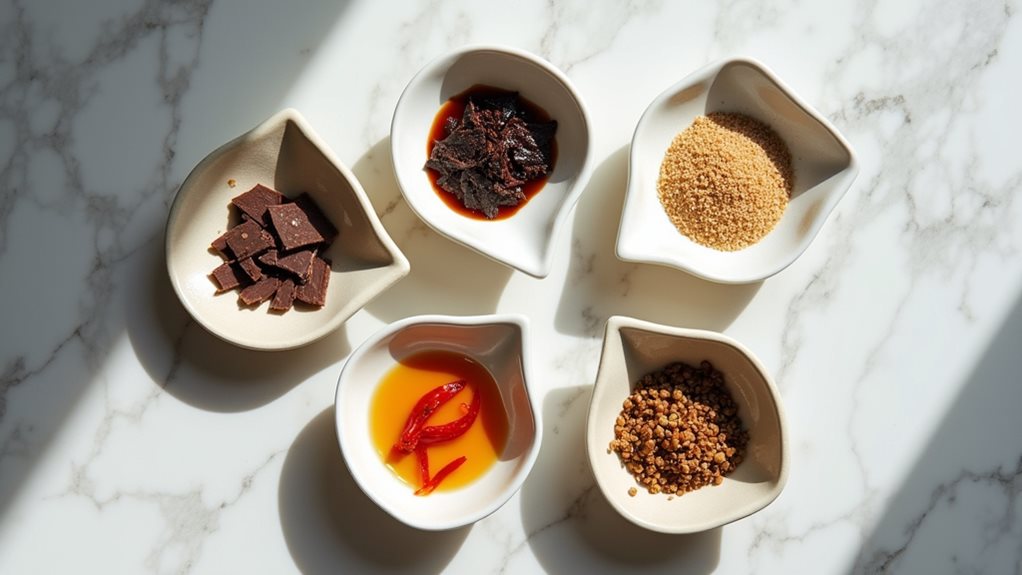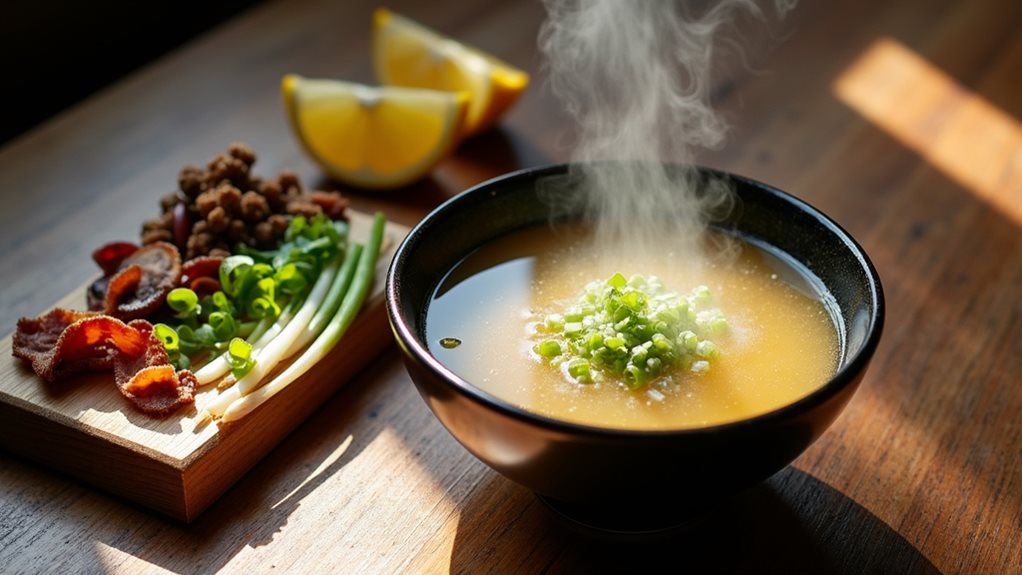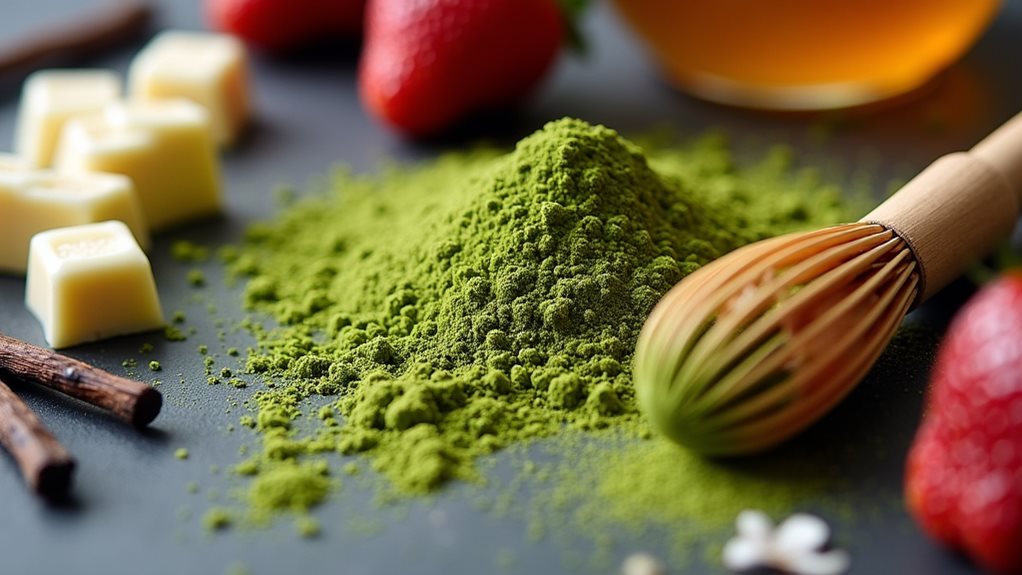Miso pairs wonderfully with both traditional and unexpected ingredients. You'll find it complements vegetables like eggplant, mushrooms, and sweet potatoes, while enhancing proteins such as salmon, chicken, and tofu. Try combining miso with butter, honey, or citrus for depth, or experiment with cross-cultural matches like olive oil and Parmesan. Even sweet applications work—white miso elevates chocolate chip cookies and caramel. The versatility of this fermented paste extends far beyond soup, with endless flavor-enhancing possibilities to explore.
The Science Behind Miso's Umami Magic

Umami, the fifth taste sensation beyond sweet, sour, salty, and bitter, lies at the heart of miso's culinary power. When you incorporate miso into your dishes, you're tapping into complex umami chemistry that transforms ordinary meals into extraordinary experiences.
This fermented paste contains high levels of glutamate, the amino acid responsible for that deep, savory quality that makes food irresistible.
The fermentation process is where the magic happens. Koji mold (Aspergillus oryzae) works alongside bacteria and yeasts to break down proteins into amino acids and starches into sugars, creating miso's distinctive flavor profiles. The versatility of miso is evident in its various types, including sweet shiro miso and more pungent aka miso varieties. What's fascinating is that this process is similar to how iconic Japanese foods like dashi and sake develop their synergistic umami compounds.
Your taste receptors detect these compounds not just on your tongue but throughout your digestive system, explaining why miso's impact feels so profound. For maximum flavor extraction, consider infusion techniques that allow miso to gradually release its complex flavors into your dishes. Understanding this science helps you leverage miso's potential to reduce sodium while maximizing flavor.
Classic Japanese Pairings That Showcase Miso
In Japanese cuisine, the art of pairing miso with complementary ingredients has evolved over centuries, creating flavor combinations that perfectly showcase this fermented paste's depth and versatility.
Traditional miso soup highlights the simplicity of this approach, combining tofu and seaweed with dashi for a breakfast staple that awakens your palate.
A harmony of silken tofu, delicate seaweed, and umami-rich dashi—traditional miso soup embodies Japanese culinary minimalism at its finest.
For more substantial options, try miso ramen with rich pork broth or saba no misoni, where mackerel bathes in umami-laden miso.
You'll find vegetables equally transformed—eggplant becomes decadent when topped with a caramelized miso glaze, while a vibrant miso dressing elevates any salad. The fermentation process creates lactic acid bacteria that contribute to both flavor development and gut health benefits. Exploring different regional recipes can introduce you to countless ingredient combinations beyond the standard American version that dominates restaurant menus.
For protein, a miso marinade works wonders on salmon, chicken, or beef, creating a caramelized exterior that locks in moisture.
Miso paste is incredibly versatile as it contains rich umami flavor that enhances carby foods like pasta and potatoes with just a small amount.
Consider experimenting with a miso spread for sandwiches or crackers as an accessible entry point.
Unexpected Sweet Combinations With Miso

While many people associate miso exclusively with savory applications, this fermented wonder surprisingly shines in sweet dishes, creating complex flavor profiles you'd never expect.
Miso desserts offer a perfect balance of salt, umami, and sweetness that elevates ordinary treats to extraordinary creations.
Try incorporating white miso into chocolate chip cookies or caramel sauce for depth that transforms these classics.
Fruit-based dishes, like mango salad with miso dressing or pear compote, benefit from miso's savory notes contrasting with natural sweetness.
Even traditional global desserts gain complexity—imagine miso cheesecake or coconut rice pudding with a subtle umami backdrop.
For an accessible introduction to savory sweets, start with miso-glazed roasted carrots or sweet potatoes, which bridge the gap between conventional savory and sweet applications. The tangy, rich complexity of miso can even enhance dessert bars with graham cracker crusts similar to those found in Caramel Apple Cheesecake Bars. Using what's already in your kitchen, you can experiment with these combinations without planning a specific trip to the store.
Elevating Plant-Based Dishes With Miso
Moving from the surprising world of miso sweets, let's explore how this fermented paste transforms plant-based cooking into something extraordinary.
Miso's ancient fermentation magic transforms humble plant ingredients into dishes with extraordinary depth and complexity.
You'll discover that miso's umami depth creates flavor dimensions previously unattainable in vegetable-forward cuisine. For tofu transformation, try marinating cubes in white miso, soy milk, and grains before baking until caramelized. When massaged directly into raw kale, miso sauce helps tenderize the leaves and intensifies their flavor profile.
When seeking chickpea enhancement, blend red miso with nutritional yeast and garlic powder for a savory coating that elevates these protein-packed legumes. Miso's cheesy fermented quality makes it perfect for creating dairy-free alternatives in plant-based cooking. The lactic acid bacteria present in miso contributes to its distinctive tangy notes while enhancing the overall umami experience.
- Combine different miso varieties (white, yellow, red) in a single dish to create complex flavor profiles that mimic traditional meat-based dishes.
- Layer miso applications—use it in both marinades and finishing sauces for depth.
- Incorporate miso into cashew-based creams for plant-based alternatives to dairy-based sauces.
Miso in Global Cuisine: Cross-Cultural Flavor Matches

Miso's remarkable versatility extends far beyond its Japanese origins, creating delicious cross-cultural flavor matches that might surprise even seasoned chefs.
These diverse miso flavor profiles can transform dishes from virtually any culinary tradition. Try pairing miso with olive oil and Parmigiano-Reggiano for Mediterranean depth, or blend it with cumin and lime juice for Latin American flair. Understanding these flavor profiles enhances cooking skills and lets you experiment with miso's unique umami characteristics across different cuisines. Writing about these creative combinations can help readers better visualize complex ideas that bridge cultural cooking methods.
In Middle Eastern cooking, you'll find miso works beautifully with sumac and pomegranate, while fusion cuisine benefits from combining miso with coconut milk and curry spices.
For Western dishes, consider mixing miso with butter and thyme to create rich, savory sauces. The adaptability of miso means you can enhance global miso dishes with complementary ingredients like garam masala, saffron, or even French bouillon.
Seasonal Ingredients That Shine With Miso
Seasons dramatically influence which ingredients pair most harmoniously with miso, creating a year-round palette of flavor possibilities you can explore in your kitchen.
From winter's hearty squash to summer's vibrant tomatoes, each season offers unique miso pairings that maximize flavor and freshness.
Spring asparagus takes on new complexity with a miso glaze, while autumn mushrooms and miso create an umami-rich foundation for comforting dishes.
- Roasted seasonal vegetables benefit from miso's transformative properties, particularly root vegetables in winter and grilled zucchini in summer.
- Stone fruits like peaches create unexpected sweet-savory combinations when paired with lighter miso varieties.
- Fresh herbs balance miso's robustness, with parsley working year-round and basil creating bright summer flavor profiles.
For a delicious winter dish, try preparing a miso-glazed root vegetable medley roasted at 425°F (220°C) until golden-brown and tender, allowing the miso to enhance the vegetables' natural sweetness.
Creating Balanced Marinades and Sauces With Miso
The art of creating balanced miso marinades and sauces transforms everyday proteins and vegetables into flavor-rich culinary experiences.
Miso magic turns ordinary ingredients into extraordinary dishes, balancing umami depth with subtle sweetness.
When crafting these savory concoctions, understanding proper miso ratios is essential—typically 1-2 tablespoons per cup of liquid yields perfect flavor depth without overwhelming saltiness.
For fish like salmon or black cod, you'll want to respect marinade timing of 8-24 hours for best flavor absorption, while chicken requires just 30 minutes minimum.
Balance your creation with complementary ingredients: rice vinegar adds tanginess, while honey or maple syrup counteracts saltiness. Don't overlook sesame oil for nutty depth and that desirable caramelization when cooking.
Consider blooming spices in oil before adding miso to release essential oils and create more aromatic depth in your marinade.
Store your finished sauces refrigerated for up to three weeks, and remember they're wonderfully adaptable—serving equally well as dressings, dips, or glazes.
Frequently Asked Questions
Does Miso Expire, and How Should It Be Properly Stored?
Your miso won't easily expire – it's got a long shelf life! Store it refrigerated in an airtight container, using clean utensils. You'll enjoy peak flavor within 3-6 months, though it's generally safe for a year.
Can Different Types of Miso Be Substituted for Each Other?
While you might worry about texture variations, yes, you can swap miso types—but expect different results. White miso's delicate sweetness differs dramatically from red miso's robust intensity. Consider blending types to customize miso flavor profiles in your dishes.
How Can I Reduce Miso's Saltiness in My Dishes?
You'll find success with miso dilution techniques: gradually add it to dishes, thin with sake or olive oil first, and balance with sweet ingredients like butter or honey to counteract saltiness while preserving umami depth.
Is Miso Suitable for People With Soy Allergies?
No, you shouldn't consume miso if you have a soy allergy, despite its reduced allergenicity through fermentation. Explore miso alternatives like chickpea miso or mushroom-based umami pastes to safely capture similar flavor profiles.
What's the Difference Between White, Yellow, and Red Miso?
You'll discover that miso flavor profiles differ primarily by fermentation process: white miso ferments briefly for a sweet, mild taste; yellow offers balanced flavor; red undergoes extended fermentation for a bold, intense character.
Final Thoughts
Like a quiet maestro conducting a symphony of flavors, miso transforms any dish it touches. You've now explored how this ancient fermented paste works across culinary boundaries, from traditional Japanese applications to unexpected global pairings. Whether you're creating umami-rich marinades or balancing sweet desserts, you'll find miso's depth adapts beautifully to your culinary explorations. Trust your palate, experiment freely, and let miso's complex character elevate your cooking to new heights.















